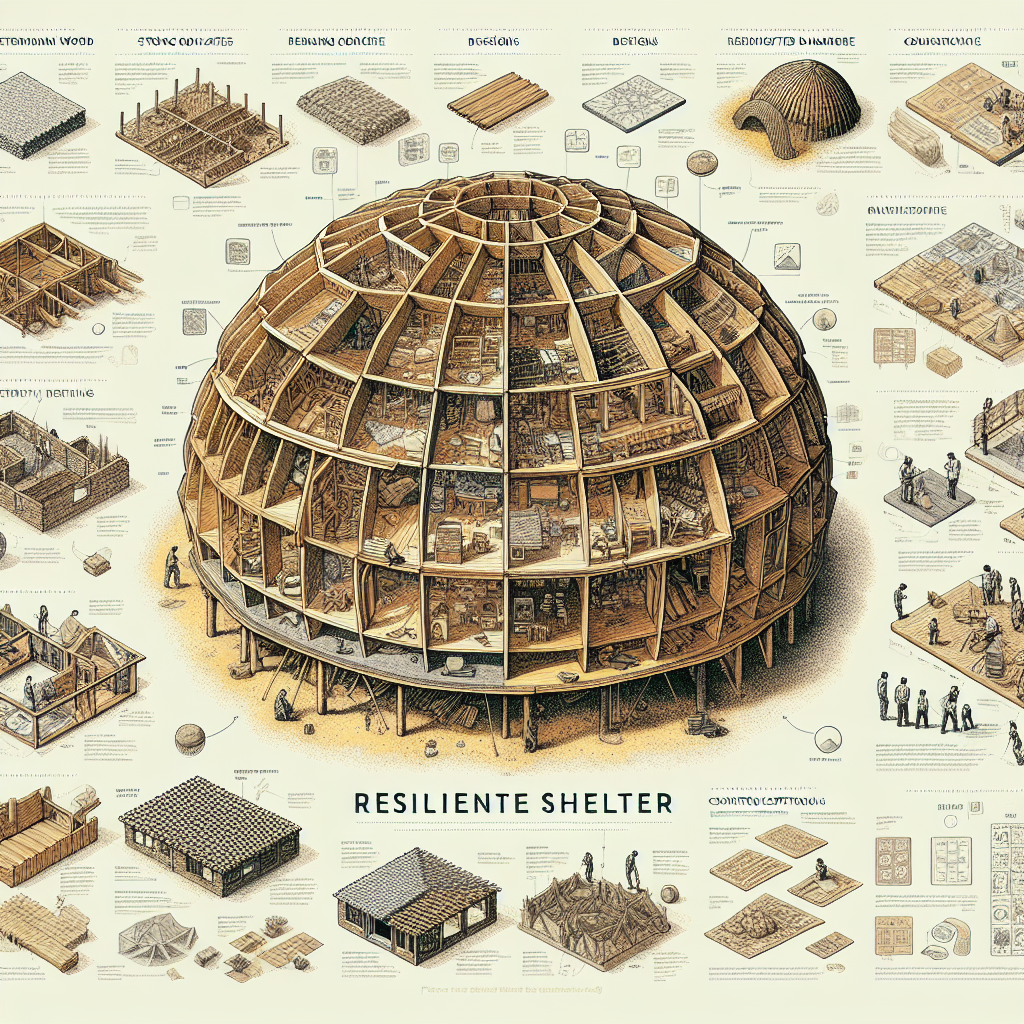When it comes to building a sturdy shelter, there are a few key fundamentals that you need to keep in mind. Whether you’re camping in the wilderness or preparing for a natural disaster, knowing how to construct a reliable shelter can make all the difference. In this article, we’ll explore the essential elements of building a sturdy shelter and provide some helpful tips to ensure that you’re well-prepared for any situation. So, grab your tools and let’s get started on creating a safe and secure haven in the great outdoors.
Choosing a Location
Survey the area
When choosing a location for your shelter, it is crucial to survey the area thoroughly. Take note of the surrounding environment, including the proximity to water sources, vegetation, and potential hazards such as steep slopes or rocky terrain. Look for a level and stable area that offers sufficient space for your shelter.
Consider natural elements
The natural elements, such as sunlight, wind, and rain, play a significant role in the overall comfort and functionality of your shelter. Consider the direction of the sun throughout the day to determine the best placement for windows and ventilation. Additionally, take into account the prevailing wind patterns to avoid potential drafts and ensure proper airflow.
Ensure accessibility
Accessibility should be a priority when selecting a location for your shelter. Consider the ease of access for yourself and others who may need to utilize the space in case of an emergency. Make sure the location is easily reachable from other important areas, such as the main road or a water source. It is important to ensure that your shelter is not isolated or difficult to reach in case of emergencies or when supplies need to be transported.
Understanding the Climate
Assess the temperature range
Understanding the temperature range of the area where your shelter will be located is crucial for creating a comfortable living environment. Gather information about the average high and low temperatures throughout the year. This will help you determine the insulation requirements and heating or cooling systems necessary to maintain a comfortable temperature inside the shelter.
Evaluate precipitation patterns
Precipitation patterns are a critical factor to consider when building a sturdy shelter. Excessive rainfall or snowfall can lead to leaks, water damage, and structural issues. Research the average annual rainfall and the possibility of heavy storms or snowfall in the area. This information will help you design a proper drainage system to effectively channel water away from your shelter.
Account for wind speed and direction
Wind can significantly impact the structural integrity of your shelter. Know the average wind speed and the prevailing wind direction in the area. This information will help you determine the appropriate design and materials to withstand strong winds. Consider the placement of windows and doors to minimize the risk of damage due to wind pressure.

Designing the Structure
Determine the purpose of the shelter
Before designing the structure, it is essential to determine the purpose of your shelter. Whether it is for temporary camping, a long-term residence, or an emergency refuge, the purpose will influence the design considerations. A temporary shelter may be smaller and more portable, while a long-term residence requires more space and amenities.
Select an appropriate size
The size of your shelter will depend on various factors, including the number of occupants, the intended use, and the available resources. Make sure to allocate enough space for everyone to be comfortable and for storage purposes. Consider the height of the shelter as well, allowing enough headroom for standing and moving around.
Decide on the shape and materials
The shape and materials of your shelter are critical for its overall strength and durability. Take into consideration the climate and natural elements in the area. A sloped roof with a steep angle will facilitate rain and snow runoff. Additionally, select materials that are suitable for the climate, ensuring they are resistant to moisture, pests, and wear and tear.
Creating a Solid Foundation
Clear the ground
Before laying the foundation for your shelter, ensure that the ground is cleared of any debris, rocks, or vegetation. Clearing the area will provide a clean and level surface for the foundation.
Level the surface
A level surface is essential for a sturdy foundation. Use a leveling tool or seek professional assistance to ensure the ground is perfectly level. Uneven ground can lead to structural issues and compromise the stability of your shelter.
Prepare the footing
Once the ground is cleared and leveled, it is time to prepare the footing. Dig trenches according to the size and shape of your shelter’s foundation. Install a layer of gravel in the trenches to improve drainage and stability. The footing will provide a solid base for your shelter’s foundation.

Constructing the Walls
Choose the wall type
There are various wall types to consider when constructing your shelter. The choice depends on factors such as the climate, availability of materials, and personal preference. Common options include concrete, wood, brick, and metal. Research each material’s pros and cons to determine the most suitable choice for your shelter.
Frame the walls
Framing the walls involves creating a skeletal structure that supports and connects the different wall materials. Depending on the chosen wall type, you may need to build a wooden or metal frame. This framework provides stability and strength to your shelter’s walls.
Install insulation
Insulation is vital for maintaining a comfortable temperature inside your shelter and reducing energy consumption. Install insulation materials within the wall cavities to prevent heat loss or gain. Consider the climate when choosing the appropriate insulation material and ensure it complies with local building codes.
Installing the Roof
Select the roof style
When it comes to selecting the roof style, consider the climate, aesthetic preferences, and practicality. Common roof styles include gable, hip, flat, or shed. Each style offers unique benefits in terms of water runoff, durability, and architectural appeal. Choose a style that suits your specific needs and complements the overall design of your shelter.
Build the roof trusses
Roof trusses provide structural support and stability for the roof. Depending on the size and shape of your shelter, design and build trusses capable of withstanding the expected weather conditions. Ensure proper installation to distribute the weight evenly and prevent any potential roof collapse.
Lay the roofing material
Selecting the appropriate roofing material is crucial for protecting your shelter from the elements. Consider factors such as durability, resistance to wind and water, and compatibility with the overall design. Common roofing materials include asphalt shingles, metal panels, clay tiles, or thatch. Follow the manufacturer’s instructions for proper installation to ensure a watertight and long-lasting roof.
Ventilation and Insulation
Plan for proper airflow
Proper ventilation is essential for a healthy and comfortable living environment. Plan the placement of windows and vents strategically to promote good airflow and air exchange. This will help prevent moisture buildup, reduce the risk of mold growth, and maintain optimal air quality inside the shelter.
Install vents and windows
Install vents and windows to facilitate airflow and natural light within your shelter. Consider the size, type, and placement of these openings to maximize their effectiveness. Adjustable vents and windows allow you to control the amount of fresh air and natural light entering the space, ensuring a pleasant living environment.
Add insulation to regulate temperature
Insulation not only helps maintain a comfortable temperature but also improves energy efficiency. Install insulation in the walls, roof, and floors to minimize heat loss during cold seasons and heat gain during hot seasons. The insulation will create a thermal barrier, reducing the reliance on heating and cooling systems.
Waterproofing and Drainage
Apply weather-resistant coatings
To protect your shelter from water damage, apply weather-resistant coatings to the exterior surfaces, such as walls and roof. These coatings, such as waterproof paints or sealants, create a barrier against moisture infiltration. Properly applied coatings can extend the lifespan of your shelter and prevent costly repairs.
Install gutters and downspouts
Gutters and downspouts are essential for effective water drainage. Install gutters along the roof edges to collect rainwater and direct it away from the foundation of your shelter. The downspouts will channel the water further away, preventing any potential water damage or flooding around the structure.
Create effective drainage systems
Consider the natural slope of the land when designing drainage systems for your shelter. Proper grading ensures that water flows away from the shelter, preventing the accumulation of excess moisture. If necessary, install French drains or other drainage solutions to effectively redirect water away from the foundation and surrounding areas.
Securing Doors and Windows
Choose sturdy doors and windows
When it comes to securing your shelter, choosing sturdy doors and windows is crucial. Opt for materials that are resistant to forced entry and durable enough to withstand varying weather conditions. Reinforced glass and strong locks provide an added layer of security against potential threats.
Install secure locks
Install secure locks on all doors and windows to enhance safety and provide peace of mind. Deadbolt locks, which are more secure than standard locksets, can significantly reduce the risk of unauthorized access. Consider adding additional security features, such as motion sensor lights or security cameras, to further deter potential intruders.
Consider additional security measures
Depending on the location and purpose of your shelter, you may want to consider additional security measures. This can include installing security systems, reinforcing doors and windows, or even constructing a safe room within your shelter. Evaluating potential security risks and taking appropriate measures will help ensure the safety of you and your loved ones.
Emergency Preparedness
Include emergency exits
In emergencies, a reliable and accessible exit is crucial. When designing your shelter, include multiple emergency exits to provide alternative escape routes. Ensure that exits are clear of any obstructions and easy to open from the inside. Emergency exits should lead directly to a safe location outside the shelter.
Prepare for natural disasters
Depending on your location, certain natural disasters may pose a threat. Take into account potential risks such as earthquakes, hurricanes, or floods and incorporate appropriate design elements to withstand these events. Consider reinforced structural components, such as extra reinforcement at critical points, to ensure the shelter’s stability during emergencies.
Stock emergency supplies
To be fully prepared for emergencies, stock your shelter with essential supplies. These may include first aid kits, non-perishable food, water, blankets, flashlights, and communication devices. Regularly check and replenish these supplies to ensure they are up to date and readily available in case of an emergency.
Building a sturdy shelter requires careful planning and consideration of various factors. By surveying the area, understanding the climate, designing the structure strategically, and implementing proper construction techniques, you can create a shelter that will stand the test of time. Whether it is for temporary or long-term use, incorporating emergency preparedness measures ensures the safety and well-being of yourself and others. Remember, a well-built shelter provides comfort, protection, and peace of mind in any situation.
